Business Environment Analysis Report: Marks & Spencer Company
VerifiedAdded on 2021/01/01
|16
|4491
|267
Report
AI Summary
This report provides an analysis of the business environment, focusing on Marks & Spencer (M&S). It begins with an introduction to the business environment and its importance for organizational strategy. The report explores different types of organizations, including private, public, and voluntary organizations, and their respective purposes and legal structures. It then examines the size and scope of various firms, using M&S, the National Health Service (NHS), and the British Heart Foundation as examples, and discusses stakeholder analysis. The report also delves into the relationship between diverse firms' functions and their connections to company objectives and layout, highlighting the roles of departments like human resources and finance within M&S. The report utilizes SWOT and PESTLE analyses to assess the company's strengths, weaknesses, opportunities, and threats, as well as the external factors influencing its operations. Overall, the report offers a comprehensive overview of M&S's business environment, providing insights into its operations, strategic tools, and organizational structure.
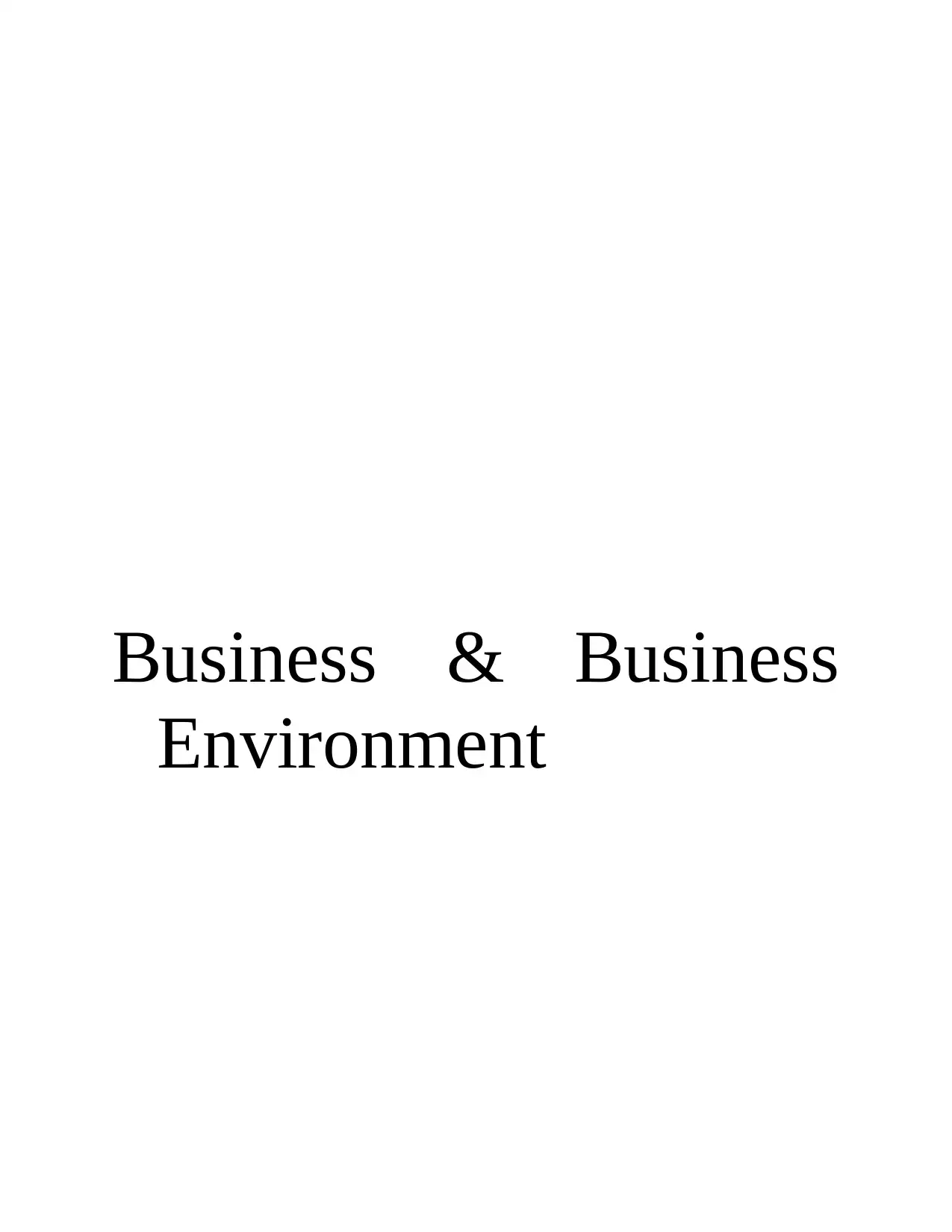
Business & Business
Environment
Environment
Secure Best Marks with AI Grader
Need help grading? Try our AI Grader for instant feedback on your assignments.

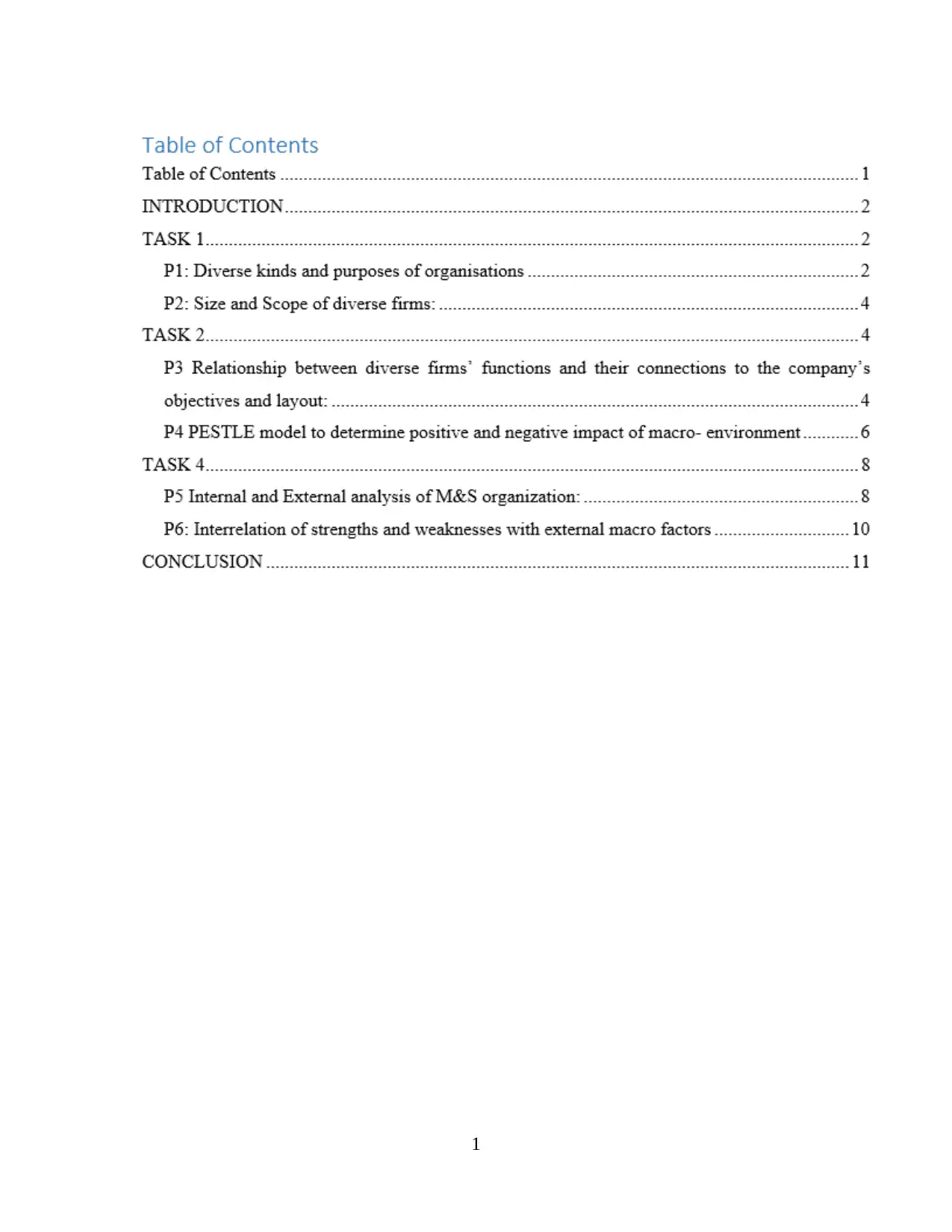
1
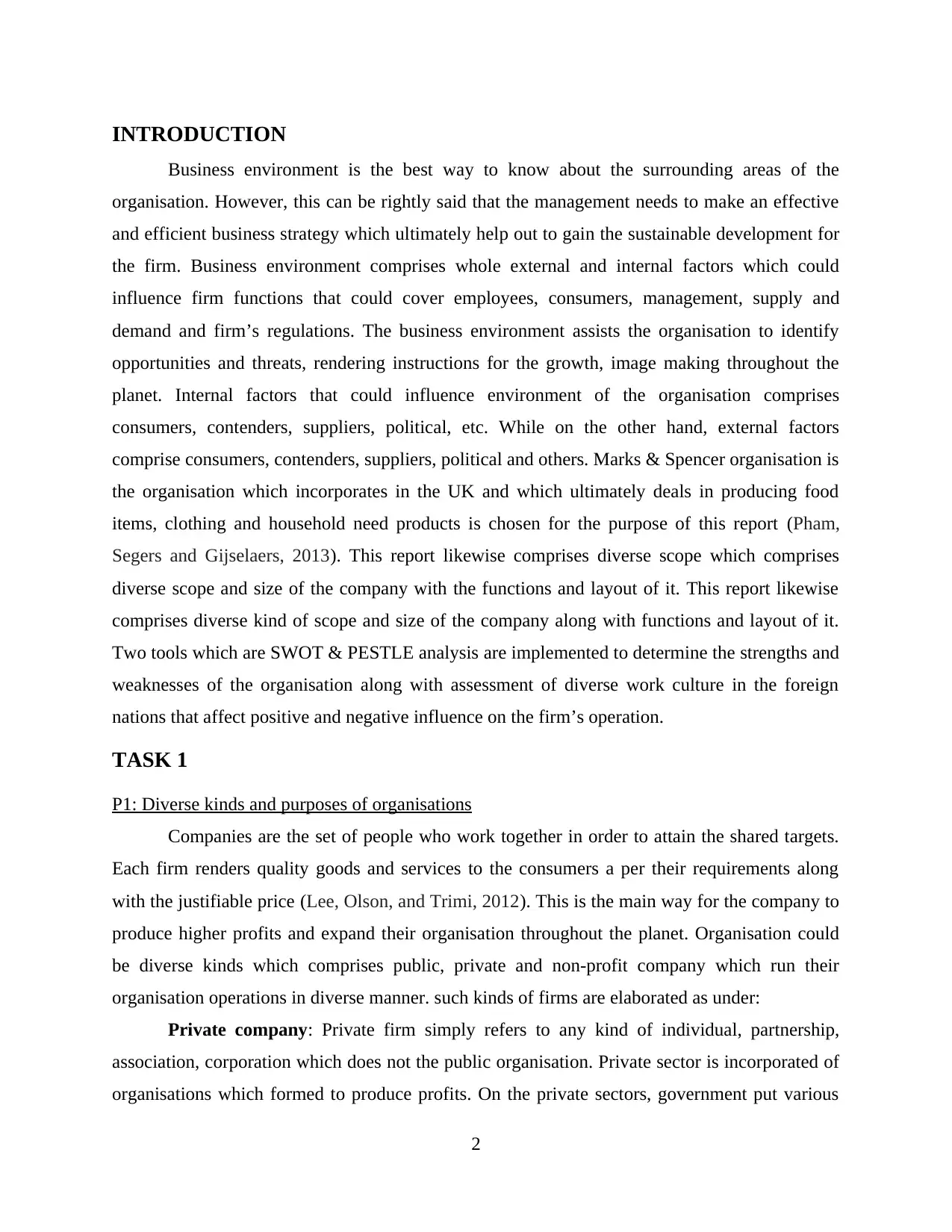
INTRODUCTION
Business environment is the best way to know about the surrounding areas of the
organisation. However, this can be rightly said that the management needs to make an effective
and efficient business strategy which ultimately help out to gain the sustainable development for
the firm. Business environment comprises whole external and internal factors which could
influence firm functions that could cover employees, consumers, management, supply and
demand and firm’s regulations. The business environment assists the organisation to identify
opportunities and threats, rendering instructions for the growth, image making throughout the
planet. Internal factors that could influence environment of the organisation comprises
consumers, contenders, suppliers, political, etc. While on the other hand, external factors
comprise consumers, contenders, suppliers, political and others. Marks & Spencer organisation is
the organisation which incorporates in the UK and which ultimately deals in producing food
items, clothing and household need products is chosen for the purpose of this report (Pham,
Segers and Gijselaers, 2013). This report likewise comprises diverse scope which comprises
diverse scope and size of the company with the functions and layout of it. This report likewise
comprises diverse kind of scope and size of the company along with functions and layout of it.
Two tools which are SWOT & PESTLE analysis are implemented to determine the strengths and
weaknesses of the organisation along with assessment of diverse work culture in the foreign
nations that affect positive and negative influence on the firm’s operation.
TASK 1
P1: Diverse kinds and purposes of organisations
Companies are the set of people who work together in order to attain the shared targets.
Each firm renders quality goods and services to the consumers a per their requirements along
with the justifiable price (Lee, Olson, and Trimi, 2012). This is the main way for the company to
produce higher profits and expand their organisation throughout the planet. Organisation could
be diverse kinds which comprises public, private and non-profit company which run their
organisation operations in diverse manner. such kinds of firms are elaborated as under:
Private company: Private firm simply refers to any kind of individual, partnership,
association, corporation which does not the public organisation. Private sector is incorporated of
organisations which formed to produce profits. On the private sectors, government put various
2
Business environment is the best way to know about the surrounding areas of the
organisation. However, this can be rightly said that the management needs to make an effective
and efficient business strategy which ultimately help out to gain the sustainable development for
the firm. Business environment comprises whole external and internal factors which could
influence firm functions that could cover employees, consumers, management, supply and
demand and firm’s regulations. The business environment assists the organisation to identify
opportunities and threats, rendering instructions for the growth, image making throughout the
planet. Internal factors that could influence environment of the organisation comprises
consumers, contenders, suppliers, political, etc. While on the other hand, external factors
comprise consumers, contenders, suppliers, political and others. Marks & Spencer organisation is
the organisation which incorporates in the UK and which ultimately deals in producing food
items, clothing and household need products is chosen for the purpose of this report (Pham,
Segers and Gijselaers, 2013). This report likewise comprises diverse scope which comprises
diverse scope and size of the company with the functions and layout of it. This report likewise
comprises diverse kind of scope and size of the company along with functions and layout of it.
Two tools which are SWOT & PESTLE analysis are implemented to determine the strengths and
weaknesses of the organisation along with assessment of diverse work culture in the foreign
nations that affect positive and negative influence on the firm’s operation.
TASK 1
P1: Diverse kinds and purposes of organisations
Companies are the set of people who work together in order to attain the shared targets.
Each firm renders quality goods and services to the consumers a per their requirements along
with the justifiable price (Lee, Olson, and Trimi, 2012). This is the main way for the company to
produce higher profits and expand their organisation throughout the planet. Organisation could
be diverse kinds which comprises public, private and non-profit company which run their
organisation operations in diverse manner. such kinds of firms are elaborated as under:
Private company: Private firm simply refers to any kind of individual, partnership,
association, corporation which does not the public organisation. Private sector is incorporated of
organisations which formed to produce profits. On the private sectors, government put various
2
Secure Best Marks with AI Grader
Need help grading? Try our AI Grader for instant feedback on your assignments.
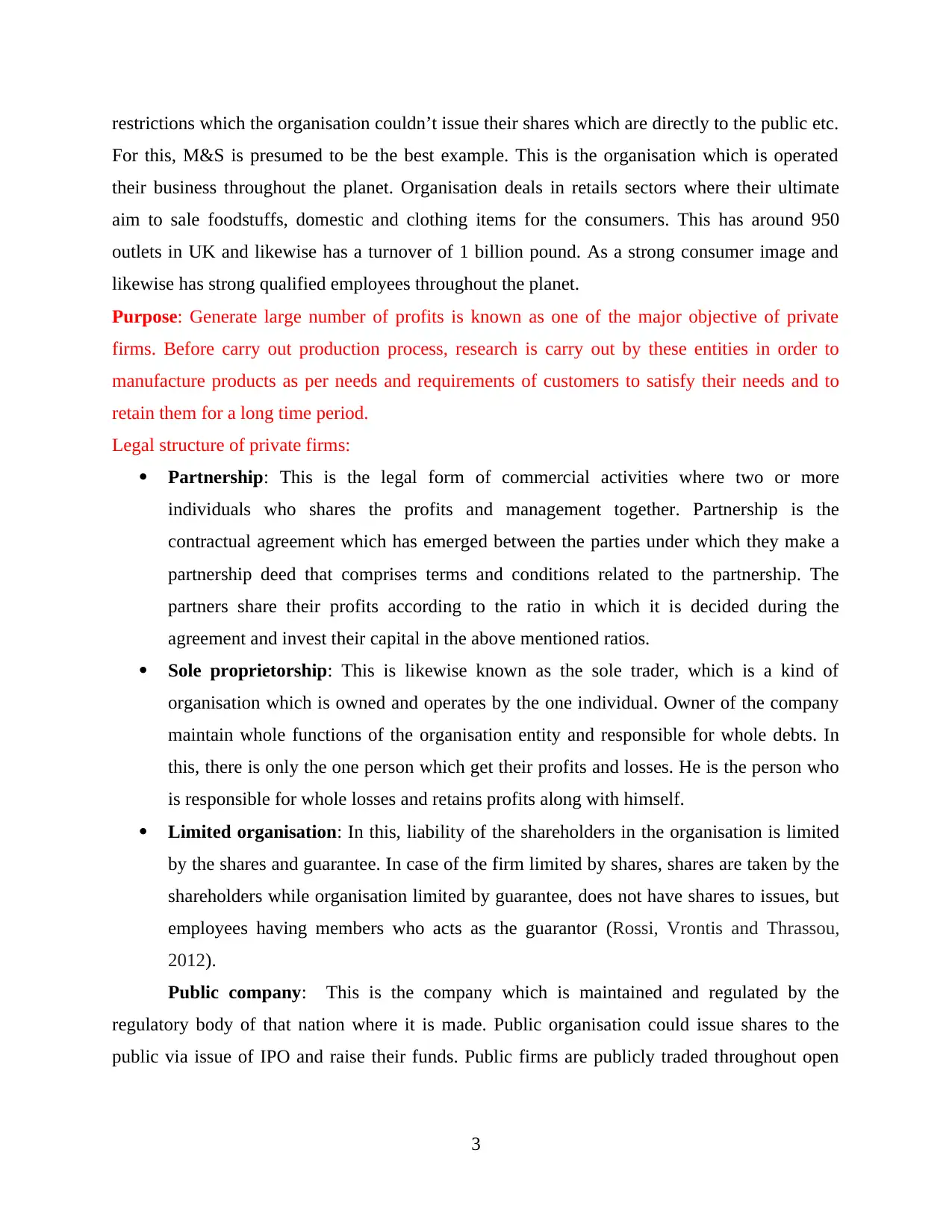
restrictions which the organisation couldn’t issue their shares which are directly to the public etc.
For this, M&S is presumed to be the best example. This is the organisation which is operated
their business throughout the planet. Organisation deals in retails sectors where their ultimate
aim to sale foodstuffs, domestic and clothing items for the consumers. This has around 950
outlets in UK and likewise has a turnover of 1 billion pound. As a strong consumer image and
likewise has strong qualified employees throughout the planet.
Purpose: Generate large number of profits is known as one of the major objective of private
firms. Before carry out production process, research is carry out by these entities in order to
manufacture products as per needs and requirements of customers to satisfy their needs and to
retain them for a long time period.
Legal structure of private firms:
Partnership: This is the legal form of commercial activities where two or more
individuals who shares the profits and management together. Partnership is the
contractual agreement which has emerged between the parties under which they make a
partnership deed that comprises terms and conditions related to the partnership. The
partners share their profits according to the ratio in which it is decided during the
agreement and invest their capital in the above mentioned ratios.
Sole proprietorship: This is likewise known as the sole trader, which is a kind of
organisation which is owned and operates by the one individual. Owner of the company
maintain whole functions of the organisation entity and responsible for whole debts. In
this, there is only the one person which get their profits and losses. He is the person who
is responsible for whole losses and retains profits along with himself.
Limited organisation: In this, liability of the shareholders in the organisation is limited
by the shares and guarantee. In case of the firm limited by shares, shares are taken by the
shareholders while organisation limited by guarantee, does not have shares to issues, but
employees having members who acts as the guarantor (Rossi, Vrontis and Thrassou,
2012).
Public company: This is the company which is maintained and regulated by the
regulatory body of that nation where it is made. Public organisation could issue shares to the
public via issue of IPO and raise their funds. Public firms are publicly traded throughout open
3
For this, M&S is presumed to be the best example. This is the organisation which is operated
their business throughout the planet. Organisation deals in retails sectors where their ultimate
aim to sale foodstuffs, domestic and clothing items for the consumers. This has around 950
outlets in UK and likewise has a turnover of 1 billion pound. As a strong consumer image and
likewise has strong qualified employees throughout the planet.
Purpose: Generate large number of profits is known as one of the major objective of private
firms. Before carry out production process, research is carry out by these entities in order to
manufacture products as per needs and requirements of customers to satisfy their needs and to
retain them for a long time period.
Legal structure of private firms:
Partnership: This is the legal form of commercial activities where two or more
individuals who shares the profits and management together. Partnership is the
contractual agreement which has emerged between the parties under which they make a
partnership deed that comprises terms and conditions related to the partnership. The
partners share their profits according to the ratio in which it is decided during the
agreement and invest their capital in the above mentioned ratios.
Sole proprietorship: This is likewise known as the sole trader, which is a kind of
organisation which is owned and operates by the one individual. Owner of the company
maintain whole functions of the organisation entity and responsible for whole debts. In
this, there is only the one person which get their profits and losses. He is the person who
is responsible for whole losses and retains profits along with himself.
Limited organisation: In this, liability of the shareholders in the organisation is limited
by the shares and guarantee. In case of the firm limited by shares, shares are taken by the
shareholders while organisation limited by guarantee, does not have shares to issues, but
employees having members who acts as the guarantor (Rossi, Vrontis and Thrassou,
2012).
Public company: This is the company which is maintained and regulated by the
regulatory body of that nation where it is made. Public organisation could issue shares to the
public via issue of IPO and raise their funds. Public firms are publicly traded throughout open
3
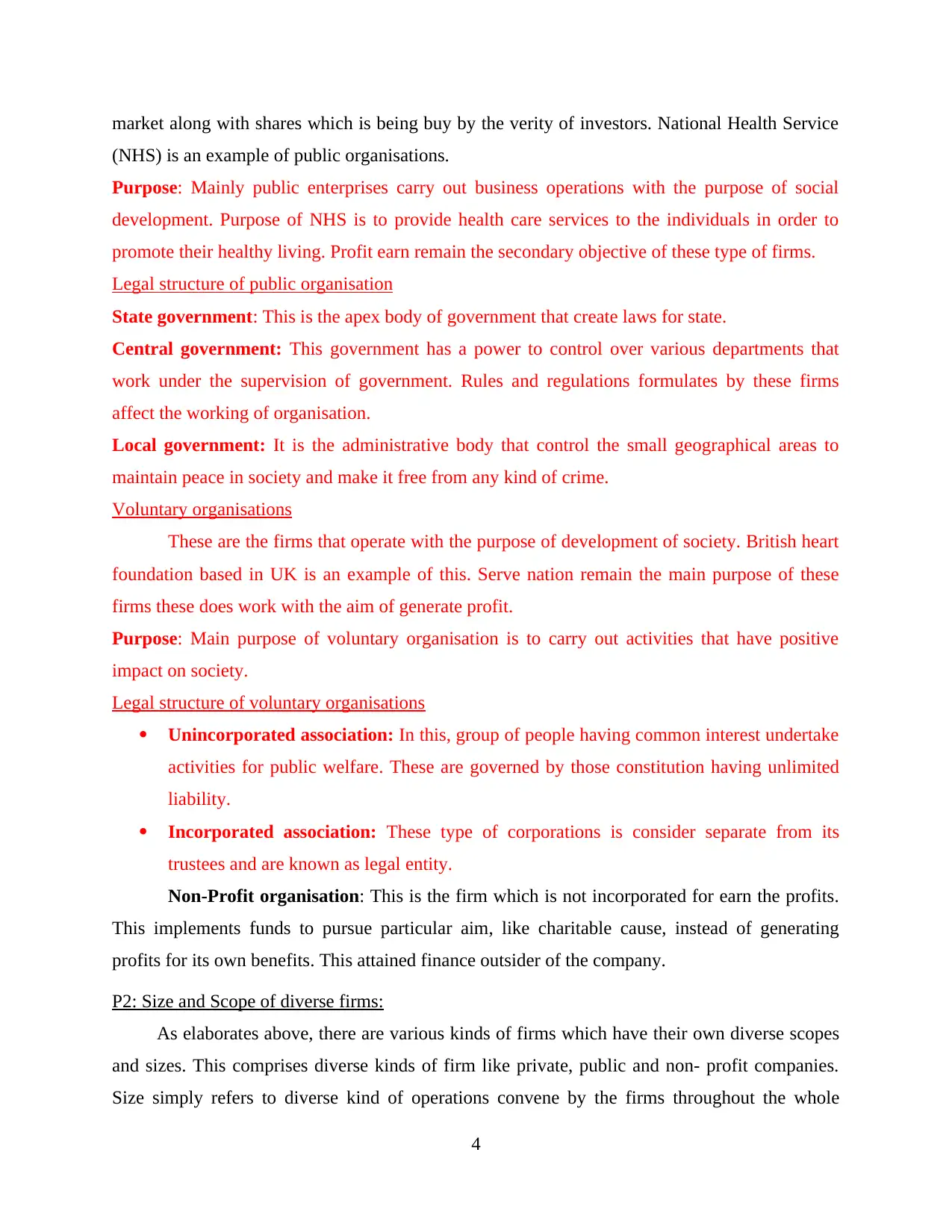
market along with shares which is being buy by the verity of investors. National Health Service
(NHS) is an example of public organisations.
Purpose: Mainly public enterprises carry out business operations with the purpose of social
development. Purpose of NHS is to provide health care services to the individuals in order to
promote their healthy living. Profit earn remain the secondary objective of these type of firms.
Legal structure of public organisation
State government: This is the apex body of government that create laws for state.
Central government: This government has a power to control over various departments that
work under the supervision of government. Rules and regulations formulates by these firms
affect the working of organisation.
Local government: It is the administrative body that control the small geographical areas to
maintain peace in society and make it free from any kind of crime.
Voluntary organisations
These are the firms that operate with the purpose of development of society. British heart
foundation based in UK is an example of this. Serve nation remain the main purpose of these
firms these does work with the aim of generate profit.
Purpose: Main purpose of voluntary organisation is to carry out activities that have positive
impact on society.
Legal structure of voluntary organisations
Unincorporated association: In this, group of people having common interest undertake
activities for public welfare. These are governed by those constitution having unlimited
liability.
Incorporated association: These type of corporations is consider separate from its
trustees and are known as legal entity.
Non-Profit organisation: This is the firm which is not incorporated for earn the profits.
This implements funds to pursue particular aim, like charitable cause, instead of generating
profits for its own benefits. This attained finance outsider of the company.
P2: Size and Scope of diverse firms:
As elaborates above, there are various kinds of firms which have their own diverse scopes
and sizes. This comprises diverse kinds of firm like private, public and non- profit companies.
Size simply refers to diverse kind of operations convene by the firms throughout the whole
4
(NHS) is an example of public organisations.
Purpose: Mainly public enterprises carry out business operations with the purpose of social
development. Purpose of NHS is to provide health care services to the individuals in order to
promote their healthy living. Profit earn remain the secondary objective of these type of firms.
Legal structure of public organisation
State government: This is the apex body of government that create laws for state.
Central government: This government has a power to control over various departments that
work under the supervision of government. Rules and regulations formulates by these firms
affect the working of organisation.
Local government: It is the administrative body that control the small geographical areas to
maintain peace in society and make it free from any kind of crime.
Voluntary organisations
These are the firms that operate with the purpose of development of society. British heart
foundation based in UK is an example of this. Serve nation remain the main purpose of these
firms these does work with the aim of generate profit.
Purpose: Main purpose of voluntary organisation is to carry out activities that have positive
impact on society.
Legal structure of voluntary organisations
Unincorporated association: In this, group of people having common interest undertake
activities for public welfare. These are governed by those constitution having unlimited
liability.
Incorporated association: These type of corporations is consider separate from its
trustees and are known as legal entity.
Non-Profit organisation: This is the firm which is not incorporated for earn the profits.
This implements funds to pursue particular aim, like charitable cause, instead of generating
profits for its own benefits. This attained finance outsider of the company.
P2: Size and Scope of diverse firms:
As elaborates above, there are various kinds of firms which have their own diverse scopes
and sizes. This comprises diverse kinds of firm like private, public and non- profit companies.
Size simply refers to diverse kind of operations convene by the firms throughout the whole
4
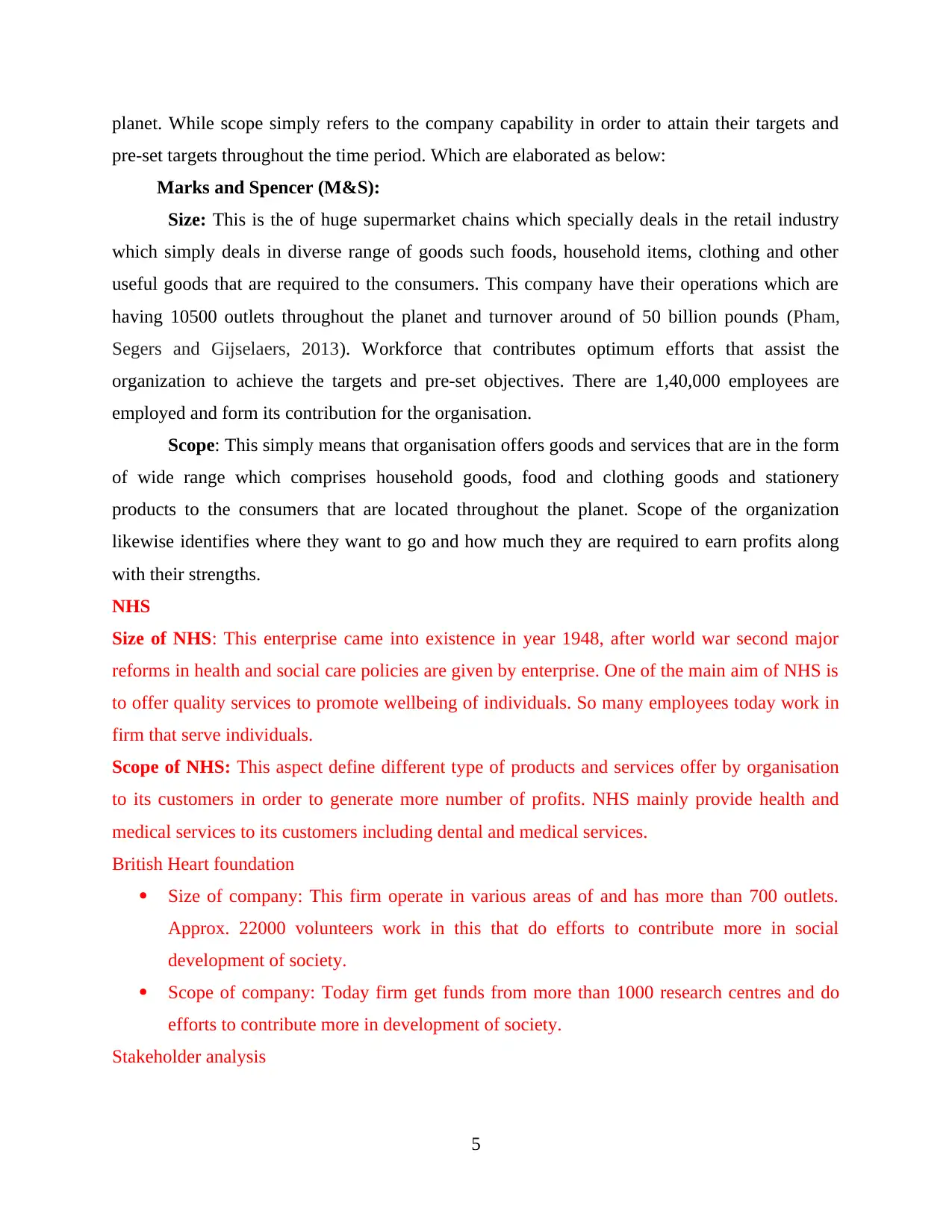
planet. While scope simply refers to the company capability in order to attain their targets and
pre-set targets throughout the time period. Which are elaborated as below:
Marks and Spencer (M&S):
Size: This is the of huge supermarket chains which specially deals in the retail industry
which simply deals in diverse range of goods such foods, household items, clothing and other
useful goods that are required to the consumers. This company have their operations which are
having 10500 outlets throughout the planet and turnover around of 50 billion pounds (Pham,
Segers and Gijselaers, 2013). Workforce that contributes optimum efforts that assist the
organization to achieve the targets and pre-set objectives. There are 1,40,000 employees are
employed and form its contribution for the organisation.
Scope: This simply means that organisation offers goods and services that are in the form
of wide range which comprises household goods, food and clothing goods and stationery
products to the consumers that are located throughout the planet. Scope of the organization
likewise identifies where they want to go and how much they are required to earn profits along
with their strengths.
NHS
Size of NHS: This enterprise came into existence in year 1948, after world war second major
reforms in health and social care policies are given by enterprise. One of the main aim of NHS is
to offer quality services to promote wellbeing of individuals. So many employees today work in
firm that serve individuals.
Scope of NHS: This aspect define different type of products and services offer by organisation
to its customers in order to generate more number of profits. NHS mainly provide health and
medical services to its customers including dental and medical services.
British Heart foundation
Size of company: This firm operate in various areas of and has more than 700 outlets.
Approx. 22000 volunteers work in this that do efforts to contribute more in social
development of society.
Scope of company: Today firm get funds from more than 1000 research centres and do
efforts to contribute more in development of society.
Stakeholder analysis
5
pre-set targets throughout the time period. Which are elaborated as below:
Marks and Spencer (M&S):
Size: This is the of huge supermarket chains which specially deals in the retail industry
which simply deals in diverse range of goods such foods, household items, clothing and other
useful goods that are required to the consumers. This company have their operations which are
having 10500 outlets throughout the planet and turnover around of 50 billion pounds (Pham,
Segers and Gijselaers, 2013). Workforce that contributes optimum efforts that assist the
organization to achieve the targets and pre-set objectives. There are 1,40,000 employees are
employed and form its contribution for the organisation.
Scope: This simply means that organisation offers goods and services that are in the form
of wide range which comprises household goods, food and clothing goods and stationery
products to the consumers that are located throughout the planet. Scope of the organization
likewise identifies where they want to go and how much they are required to earn profits along
with their strengths.
NHS
Size of NHS: This enterprise came into existence in year 1948, after world war second major
reforms in health and social care policies are given by enterprise. One of the main aim of NHS is
to offer quality services to promote wellbeing of individuals. So many employees today work in
firm that serve individuals.
Scope of NHS: This aspect define different type of products and services offer by organisation
to its customers in order to generate more number of profits. NHS mainly provide health and
medical services to its customers including dental and medical services.
British Heart foundation
Size of company: This firm operate in various areas of and has more than 700 outlets.
Approx. 22000 volunteers work in this that do efforts to contribute more in social
development of society.
Scope of company: Today firm get funds from more than 1000 research centres and do
efforts to contribute more in development of society.
Stakeholder analysis
5
Paraphrase This Document
Need a fresh take? Get an instant paraphrase of this document with our AI Paraphraser
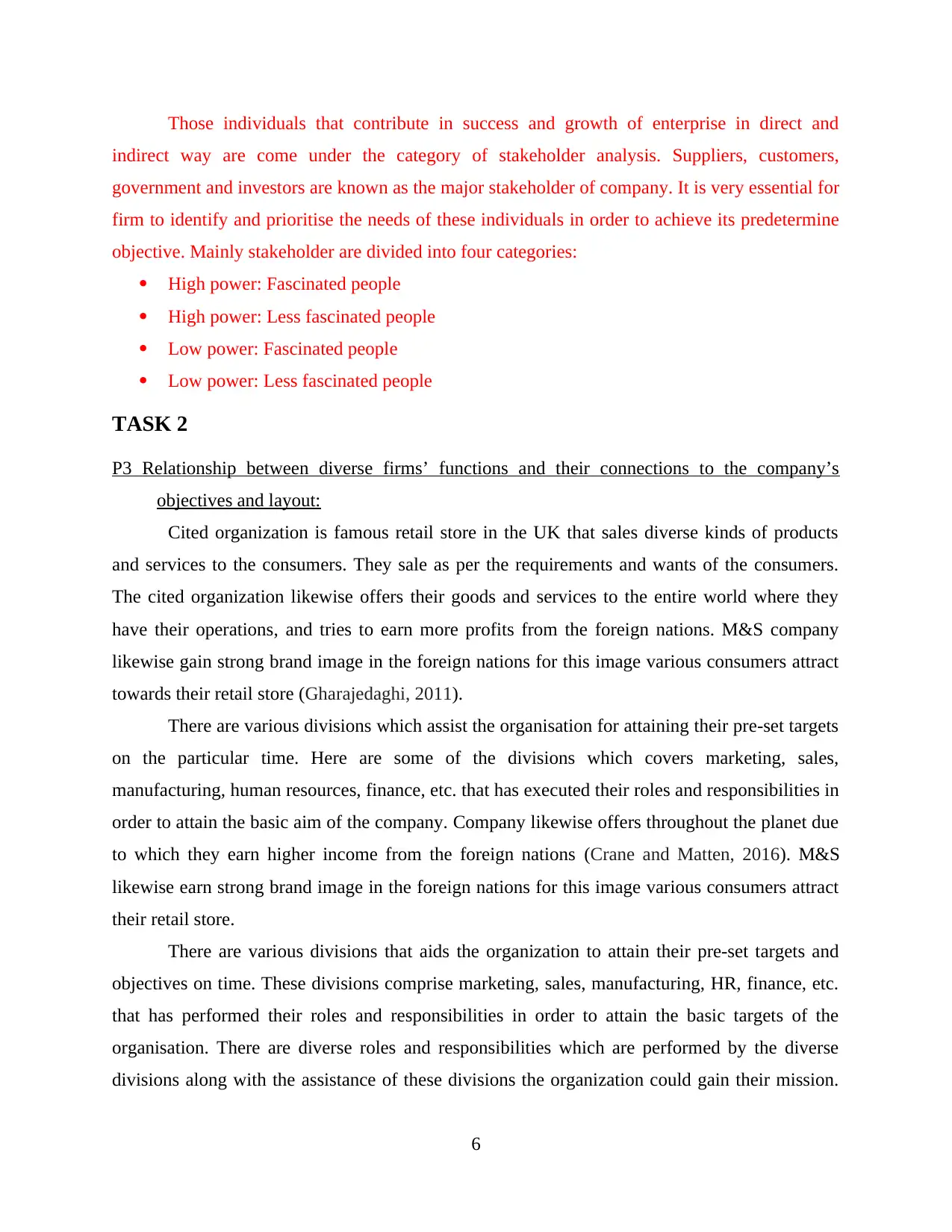
Those individuals that contribute in success and growth of enterprise in direct and
indirect way are come under the category of stakeholder analysis. Suppliers, customers,
government and investors are known as the major stakeholder of company. It is very essential for
firm to identify and prioritise the needs of these individuals in order to achieve its predetermine
objective. Mainly stakeholder are divided into four categories:
High power: Fascinated people
High power: Less fascinated people
Low power: Fascinated people
Low power: Less fascinated people
TASK 2
P3 Relationship between diverse firms’ functions and their connections to the company’s
objectives and layout:
Cited organization is famous retail store in the UK that sales diverse kinds of products
and services to the consumers. They sale as per the requirements and wants of the consumers.
The cited organization likewise offers their goods and services to the entire world where they
have their operations, and tries to earn more profits from the foreign nations. M&S company
likewise gain strong brand image in the foreign nations for this image various consumers attract
towards their retail store (Gharajedaghi, 2011).
There are various divisions which assist the organisation for attaining their pre-set targets
on the particular time. Here are some of the divisions which covers marketing, sales,
manufacturing, human resources, finance, etc. that has executed their roles and responsibilities in
order to attain the basic aim of the company. Company likewise offers throughout the planet due
to which they earn higher income from the foreign nations (Crane and Matten, 2016). M&S
likewise earn strong brand image in the foreign nations for this image various consumers attract
their retail store.
There are various divisions that aids the organization to attain their pre-set targets and
objectives on time. These divisions comprise marketing, sales, manufacturing, HR, finance, etc.
that has performed their roles and responsibilities in order to attain the basic targets of the
organisation. There are diverse roles and responsibilities which are performed by the diverse
divisions along with the assistance of these divisions the organization could gain their mission.
6
indirect way are come under the category of stakeholder analysis. Suppliers, customers,
government and investors are known as the major stakeholder of company. It is very essential for
firm to identify and prioritise the needs of these individuals in order to achieve its predetermine
objective. Mainly stakeholder are divided into four categories:
High power: Fascinated people
High power: Less fascinated people
Low power: Fascinated people
Low power: Less fascinated people
TASK 2
P3 Relationship between diverse firms’ functions and their connections to the company’s
objectives and layout:
Cited organization is famous retail store in the UK that sales diverse kinds of products
and services to the consumers. They sale as per the requirements and wants of the consumers.
The cited organization likewise offers their goods and services to the entire world where they
have their operations, and tries to earn more profits from the foreign nations. M&S company
likewise gain strong brand image in the foreign nations for this image various consumers attract
towards their retail store (Gharajedaghi, 2011).
There are various divisions which assist the organisation for attaining their pre-set targets
on the particular time. Here are some of the divisions which covers marketing, sales,
manufacturing, human resources, finance, etc. that has executed their roles and responsibilities in
order to attain the basic aim of the company. Company likewise offers throughout the planet due
to which they earn higher income from the foreign nations (Crane and Matten, 2016). M&S
likewise earn strong brand image in the foreign nations for this image various consumers attract
their retail store.
There are various divisions that aids the organization to attain their pre-set targets and
objectives on time. These divisions comprise marketing, sales, manufacturing, HR, finance, etc.
that has performed their roles and responsibilities in order to attain the basic targets of the
organisation. There are diverse roles and responsibilities which are performed by the diverse
divisions along with the assistance of these divisions the organization could gain their mission.
6
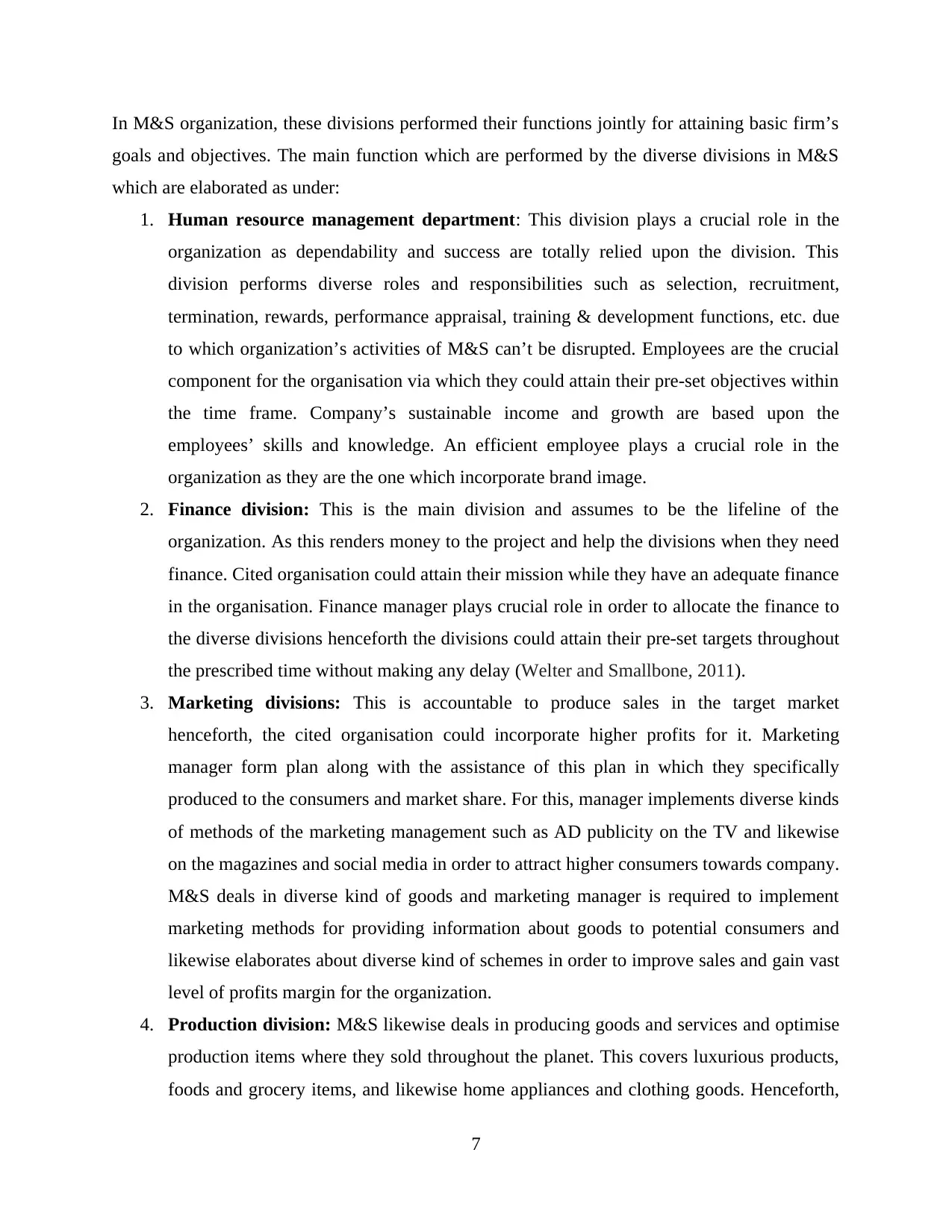
In M&S organization, these divisions performed their functions jointly for attaining basic firm’s
goals and objectives. The main function which are performed by the diverse divisions in M&S
which are elaborated as under:
1. Human resource management department: This division plays a crucial role in the
organization as dependability and success are totally relied upon the division. This
division performs diverse roles and responsibilities such as selection, recruitment,
termination, rewards, performance appraisal, training & development functions, etc. due
to which organization’s activities of M&S can’t be disrupted. Employees are the crucial
component for the organisation via which they could attain their pre-set objectives within
the time frame. Company’s sustainable income and growth are based upon the
employees’ skills and knowledge. An efficient employee plays a crucial role in the
organization as they are the one which incorporate brand image.
2. Finance division: This is the main division and assumes to be the lifeline of the
organization. As this renders money to the project and help the divisions when they need
finance. Cited organisation could attain their mission while they have an adequate finance
in the organisation. Finance manager plays crucial role in order to allocate the finance to
the diverse divisions henceforth the divisions could attain their pre-set targets throughout
the prescribed time without making any delay (Welter and Smallbone, 2011).
3. Marketing divisions: This is accountable to produce sales in the target market
henceforth, the cited organisation could incorporate higher profits for it. Marketing
manager form plan along with the assistance of this plan in which they specifically
produced to the consumers and market share. For this, manager implements diverse kinds
of methods of the marketing management such as AD publicity on the TV and likewise
on the magazines and social media in order to attract higher consumers towards company.
M&S deals in diverse kind of goods and marketing manager is required to implement
marketing methods for providing information about goods to potential consumers and
likewise elaborates about diverse kind of schemes in order to improve sales and gain vast
level of profits margin for the organization.
4. Production division: M&S likewise deals in producing goods and services and optimise
production items where they sold throughout the planet. This covers luxurious products,
foods and grocery items, and likewise home appliances and clothing goods. Henceforth,
7
goals and objectives. The main function which are performed by the diverse divisions in M&S
which are elaborated as under:
1. Human resource management department: This division plays a crucial role in the
organization as dependability and success are totally relied upon the division. This
division performs diverse roles and responsibilities such as selection, recruitment,
termination, rewards, performance appraisal, training & development functions, etc. due
to which organization’s activities of M&S can’t be disrupted. Employees are the crucial
component for the organisation via which they could attain their pre-set objectives within
the time frame. Company’s sustainable income and growth are based upon the
employees’ skills and knowledge. An efficient employee plays a crucial role in the
organization as they are the one which incorporate brand image.
2. Finance division: This is the main division and assumes to be the lifeline of the
organization. As this renders money to the project and help the divisions when they need
finance. Cited organisation could attain their mission while they have an adequate finance
in the organisation. Finance manager plays crucial role in order to allocate the finance to
the diverse divisions henceforth the divisions could attain their pre-set targets throughout
the prescribed time without making any delay (Welter and Smallbone, 2011).
3. Marketing divisions: This is accountable to produce sales in the target market
henceforth, the cited organisation could incorporate higher profits for it. Marketing
manager form plan along with the assistance of this plan in which they specifically
produced to the consumers and market share. For this, manager implements diverse kinds
of methods of the marketing management such as AD publicity on the TV and likewise
on the magazines and social media in order to attract higher consumers towards company.
M&S deals in diverse kind of goods and marketing manager is required to implement
marketing methods for providing information about goods to potential consumers and
likewise elaborates about diverse kind of schemes in order to improve sales and gain vast
level of profits margin for the organization.
4. Production division: M&S likewise deals in producing goods and services and optimise
production items where they sold throughout the planet. This covers luxurious products,
foods and grocery items, and likewise home appliances and clothing goods. Henceforth,
7
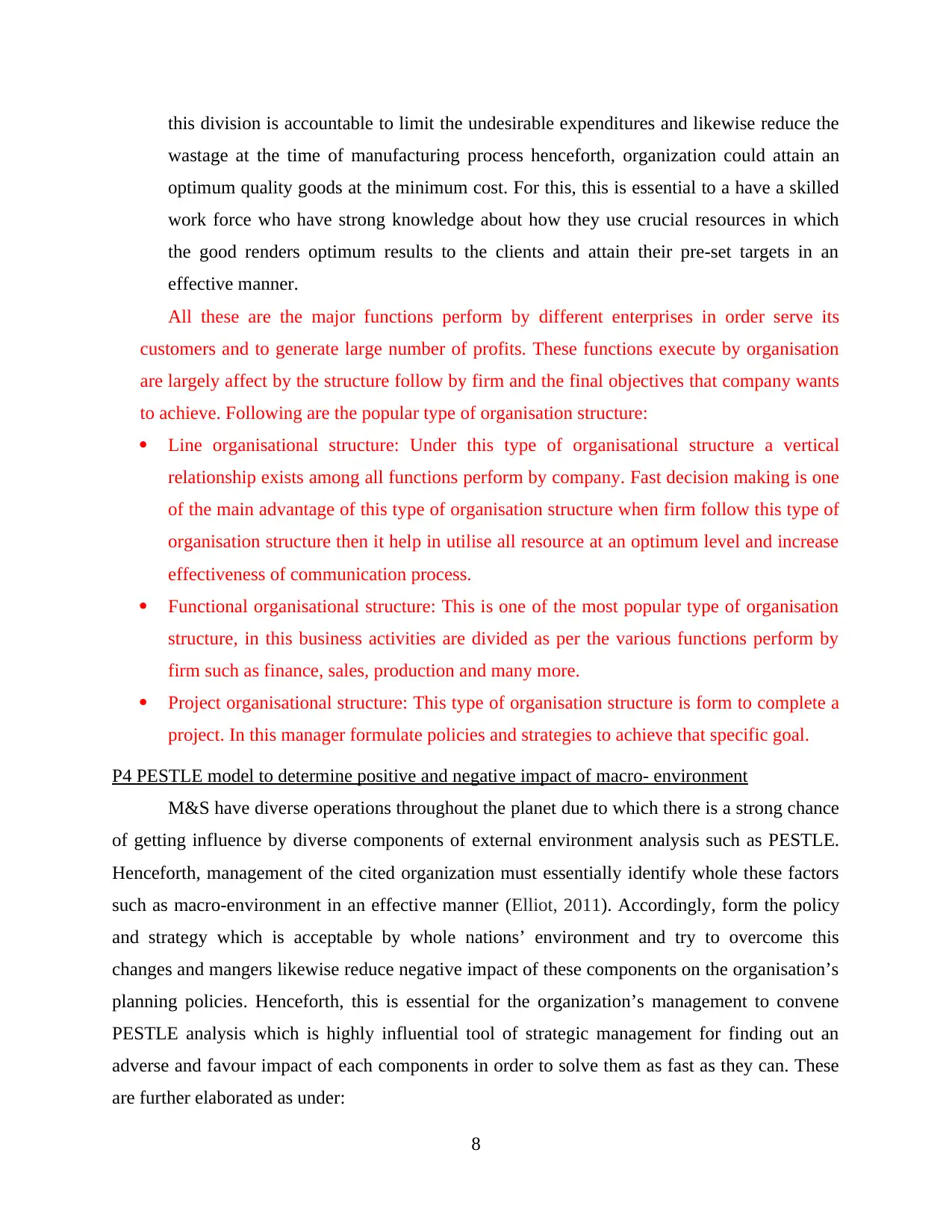
this division is accountable to limit the undesirable expenditures and likewise reduce the
wastage at the time of manufacturing process henceforth, organization could attain an
optimum quality goods at the minimum cost. For this, this is essential to a have a skilled
work force who have strong knowledge about how they use crucial resources in which
the good renders optimum results to the clients and attain their pre-set targets in an
effective manner.
All these are the major functions perform by different enterprises in order serve its
customers and to generate large number of profits. These functions execute by organisation
are largely affect by the structure follow by firm and the final objectives that company wants
to achieve. Following are the popular type of organisation structure:
Line organisational structure: Under this type of organisational structure a vertical
relationship exists among all functions perform by company. Fast decision making is one
of the main advantage of this type of organisation structure when firm follow this type of
organisation structure then it help in utilise all resource at an optimum level and increase
effectiveness of communication process.
Functional organisational structure: This is one of the most popular type of organisation
structure, in this business activities are divided as per the various functions perform by
firm such as finance, sales, production and many more.
Project organisational structure: This type of organisation structure is form to complete a
project. In this manager formulate policies and strategies to achieve that specific goal.
P4 PESTLE model to determine positive and negative impact of macro- environment
M&S have diverse operations throughout the planet due to which there is a strong chance
of getting influence by diverse components of external environment analysis such as PESTLE.
Henceforth, management of the cited organization must essentially identify whole these factors
such as macro-environment in an effective manner (Elliot, 2011). Accordingly, form the policy
and strategy which is acceptable by whole nations’ environment and try to overcome this
changes and mangers likewise reduce negative impact of these components on the organisation’s
planning policies. Henceforth, this is essential for the organization’s management to convene
PESTLE analysis which is highly influential tool of strategic management for finding out an
adverse and favour impact of each components in order to solve them as fast as they can. These
are further elaborated as under:
8
wastage at the time of manufacturing process henceforth, organization could attain an
optimum quality goods at the minimum cost. For this, this is essential to a have a skilled
work force who have strong knowledge about how they use crucial resources in which
the good renders optimum results to the clients and attain their pre-set targets in an
effective manner.
All these are the major functions perform by different enterprises in order serve its
customers and to generate large number of profits. These functions execute by organisation
are largely affect by the structure follow by firm and the final objectives that company wants
to achieve. Following are the popular type of organisation structure:
Line organisational structure: Under this type of organisational structure a vertical
relationship exists among all functions perform by company. Fast decision making is one
of the main advantage of this type of organisation structure when firm follow this type of
organisation structure then it help in utilise all resource at an optimum level and increase
effectiveness of communication process.
Functional organisational structure: This is one of the most popular type of organisation
structure, in this business activities are divided as per the various functions perform by
firm such as finance, sales, production and many more.
Project organisational structure: This type of organisation structure is form to complete a
project. In this manager formulate policies and strategies to achieve that specific goal.
P4 PESTLE model to determine positive and negative impact of macro- environment
M&S have diverse operations throughout the planet due to which there is a strong chance
of getting influence by diverse components of external environment analysis such as PESTLE.
Henceforth, management of the cited organization must essentially identify whole these factors
such as macro-environment in an effective manner (Elliot, 2011). Accordingly, form the policy
and strategy which is acceptable by whole nations’ environment and try to overcome this
changes and mangers likewise reduce negative impact of these components on the organisation’s
planning policies. Henceforth, this is essential for the organization’s management to convene
PESTLE analysis which is highly influential tool of strategic management for finding out an
adverse and favour impact of each components in order to solve them as fast as they can. These
are further elaborated as under:
8
Secure Best Marks with AI Grader
Need help grading? Try our AI Grader for instant feedback on your assignments.
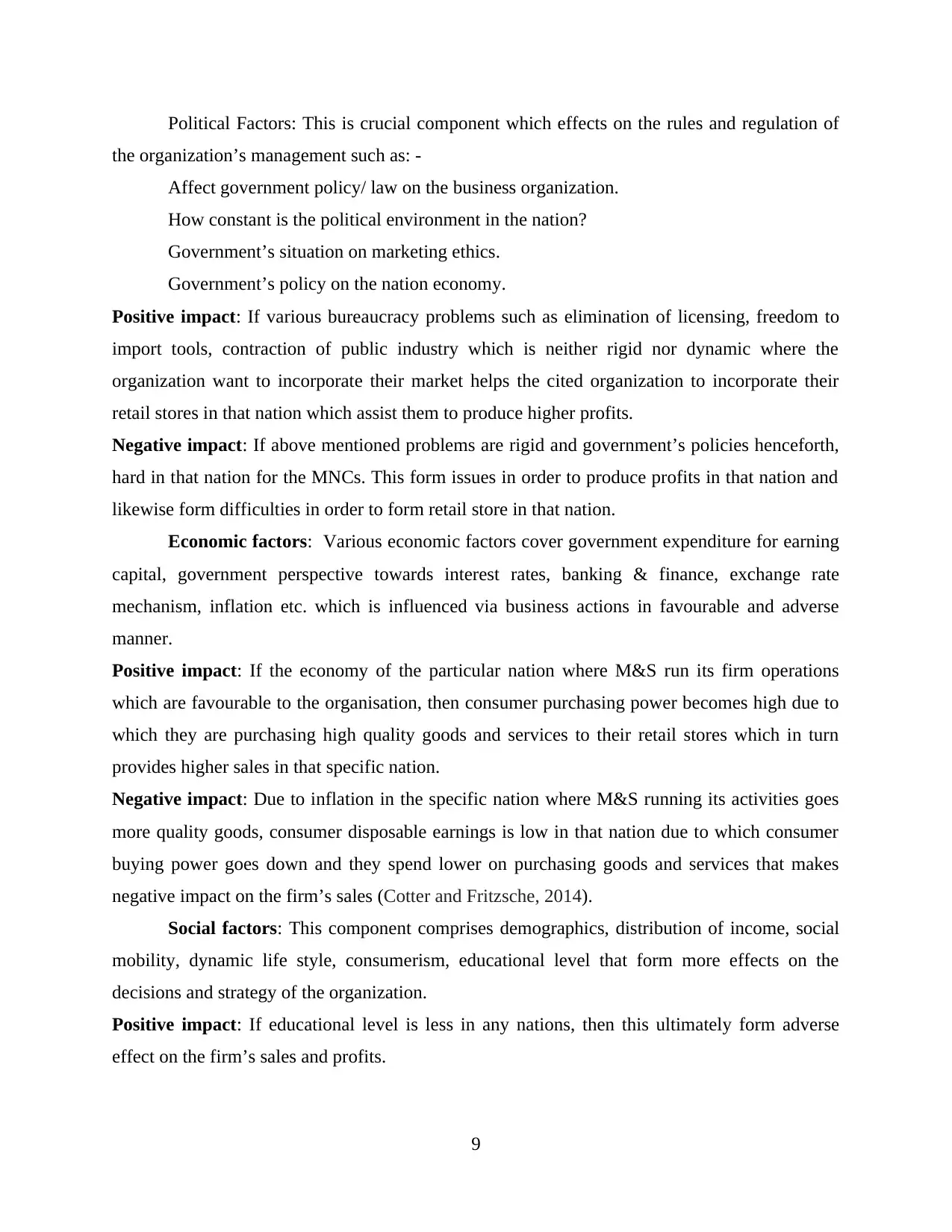
Political Factors: This is crucial component which effects on the rules and regulation of
the organization’s management such as: -
Affect government policy/ law on the business organization.
How constant is the political environment in the nation?
Government’s situation on marketing ethics.
Government’s policy on the nation economy.
Positive impact: If various bureaucracy problems such as elimination of licensing, freedom to
import tools, contraction of public industry which is neither rigid nor dynamic where the
organization want to incorporate their market helps the cited organization to incorporate their
retail stores in that nation which assist them to produce higher profits.
Negative impact: If above mentioned problems are rigid and government’s policies henceforth,
hard in that nation for the MNCs. This form issues in order to produce profits in that nation and
likewise form difficulties in order to form retail store in that nation.
Economic factors: Various economic factors cover government expenditure for earning
capital, government perspective towards interest rates, banking & finance, exchange rate
mechanism, inflation etc. which is influenced via business actions in favourable and adverse
manner.
Positive impact: If the economy of the particular nation where M&S run its firm operations
which are favourable to the organisation, then consumer purchasing power becomes high due to
which they are purchasing high quality goods and services to their retail stores which in turn
provides higher sales in that specific nation.
Negative impact: Due to inflation in the specific nation where M&S running its activities goes
more quality goods, consumer disposable earnings is low in that nation due to which consumer
buying power goes down and they spend lower on purchasing goods and services that makes
negative impact on the firm’s sales (Cotter and Fritzsche, 2014).
Social factors: This component comprises demographics, distribution of income, social
mobility, dynamic life style, consumerism, educational level that form more effects on the
decisions and strategy of the organization.
Positive impact: If educational level is less in any nations, then this ultimately form adverse
effect on the firm’s sales and profits.
9
the organization’s management such as: -
Affect government policy/ law on the business organization.
How constant is the political environment in the nation?
Government’s situation on marketing ethics.
Government’s policy on the nation economy.
Positive impact: If various bureaucracy problems such as elimination of licensing, freedom to
import tools, contraction of public industry which is neither rigid nor dynamic where the
organization want to incorporate their market helps the cited organization to incorporate their
retail stores in that nation which assist them to produce higher profits.
Negative impact: If above mentioned problems are rigid and government’s policies henceforth,
hard in that nation for the MNCs. This form issues in order to produce profits in that nation and
likewise form difficulties in order to form retail store in that nation.
Economic factors: Various economic factors cover government expenditure for earning
capital, government perspective towards interest rates, banking & finance, exchange rate
mechanism, inflation etc. which is influenced via business actions in favourable and adverse
manner.
Positive impact: If the economy of the particular nation where M&S run its firm operations
which are favourable to the organisation, then consumer purchasing power becomes high due to
which they are purchasing high quality goods and services to their retail stores which in turn
provides higher sales in that specific nation.
Negative impact: Due to inflation in the specific nation where M&S running its activities goes
more quality goods, consumer disposable earnings is low in that nation due to which consumer
buying power goes down and they spend lower on purchasing goods and services that makes
negative impact on the firm’s sales (Cotter and Fritzsche, 2014).
Social factors: This component comprises demographics, distribution of income, social
mobility, dynamic life style, consumerism, educational level that form more effects on the
decisions and strategy of the organization.
Positive impact: If educational level is less in any nations, then this ultimately form adverse
effect on the firm’s sales and profits.
9
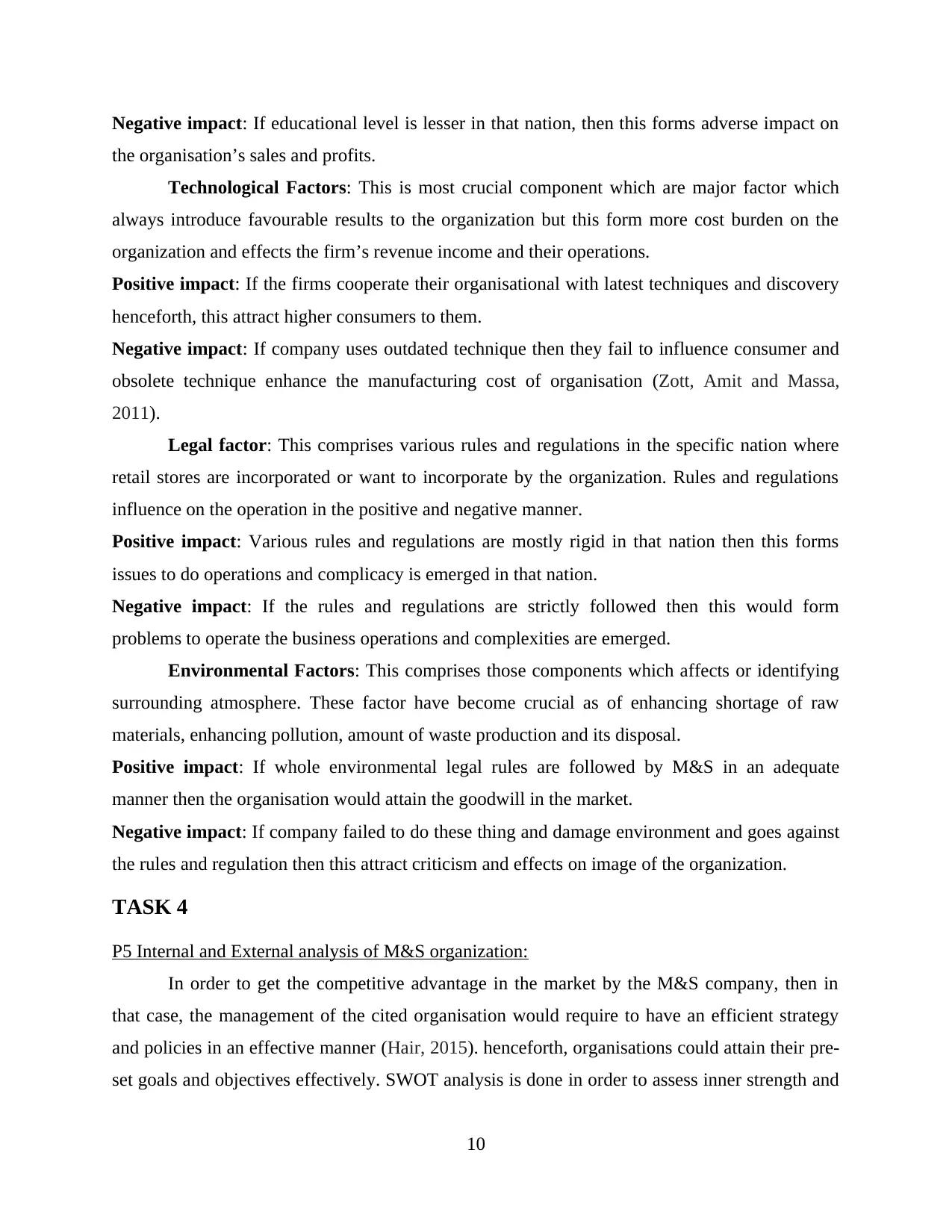
Negative impact: If educational level is lesser in that nation, then this forms adverse impact on
the organisation’s sales and profits.
Technological Factors: This is most crucial component which are major factor which
always introduce favourable results to the organization but this form more cost burden on the
organization and effects the firm’s revenue income and their operations.
Positive impact: If the firms cooperate their organisational with latest techniques and discovery
henceforth, this attract higher consumers to them.
Negative impact: If company uses outdated technique then they fail to influence consumer and
obsolete technique enhance the manufacturing cost of organisation (Zott, Amit and Massa,
2011).
Legal factor: This comprises various rules and regulations in the specific nation where
retail stores are incorporated or want to incorporate by the organization. Rules and regulations
influence on the operation in the positive and negative manner.
Positive impact: Various rules and regulations are mostly rigid in that nation then this forms
issues to do operations and complicacy is emerged in that nation.
Negative impact: If the rules and regulations are strictly followed then this would form
problems to operate the business operations and complexities are emerged.
Environmental Factors: This comprises those components which affects or identifying
surrounding atmosphere. These factor have become crucial as of enhancing shortage of raw
materials, enhancing pollution, amount of waste production and its disposal.
Positive impact: If whole environmental legal rules are followed by M&S in an adequate
manner then the organisation would attain the goodwill in the market.
Negative impact: If company failed to do these thing and damage environment and goes against
the rules and regulation then this attract criticism and effects on image of the organization.
TASK 4
P5 Internal and External analysis of M&S organization:
In order to get the competitive advantage in the market by the M&S company, then in
that case, the management of the cited organisation would require to have an efficient strategy
and policies in an effective manner (Hair, 2015). henceforth, organisations could attain their pre-
set goals and objectives effectively. SWOT analysis is done in order to assess inner strength and
10
the organisation’s sales and profits.
Technological Factors: This is most crucial component which are major factor which
always introduce favourable results to the organization but this form more cost burden on the
organization and effects the firm’s revenue income and their operations.
Positive impact: If the firms cooperate their organisational with latest techniques and discovery
henceforth, this attract higher consumers to them.
Negative impact: If company uses outdated technique then they fail to influence consumer and
obsolete technique enhance the manufacturing cost of organisation (Zott, Amit and Massa,
2011).
Legal factor: This comprises various rules and regulations in the specific nation where
retail stores are incorporated or want to incorporate by the organization. Rules and regulations
influence on the operation in the positive and negative manner.
Positive impact: Various rules and regulations are mostly rigid in that nation then this forms
issues to do operations and complicacy is emerged in that nation.
Negative impact: If the rules and regulations are strictly followed then this would form
problems to operate the business operations and complexities are emerged.
Environmental Factors: This comprises those components which affects or identifying
surrounding atmosphere. These factor have become crucial as of enhancing shortage of raw
materials, enhancing pollution, amount of waste production and its disposal.
Positive impact: If whole environmental legal rules are followed by M&S in an adequate
manner then the organisation would attain the goodwill in the market.
Negative impact: If company failed to do these thing and damage environment and goes against
the rules and regulation then this attract criticism and effects on image of the organization.
TASK 4
P5 Internal and External analysis of M&S organization:
In order to get the competitive advantage in the market by the M&S company, then in
that case, the management of the cited organisation would require to have an efficient strategy
and policies in an effective manner (Hair, 2015). henceforth, organisations could attain their pre-
set goals and objectives effectively. SWOT analysis is done in order to assess inner strength and
10
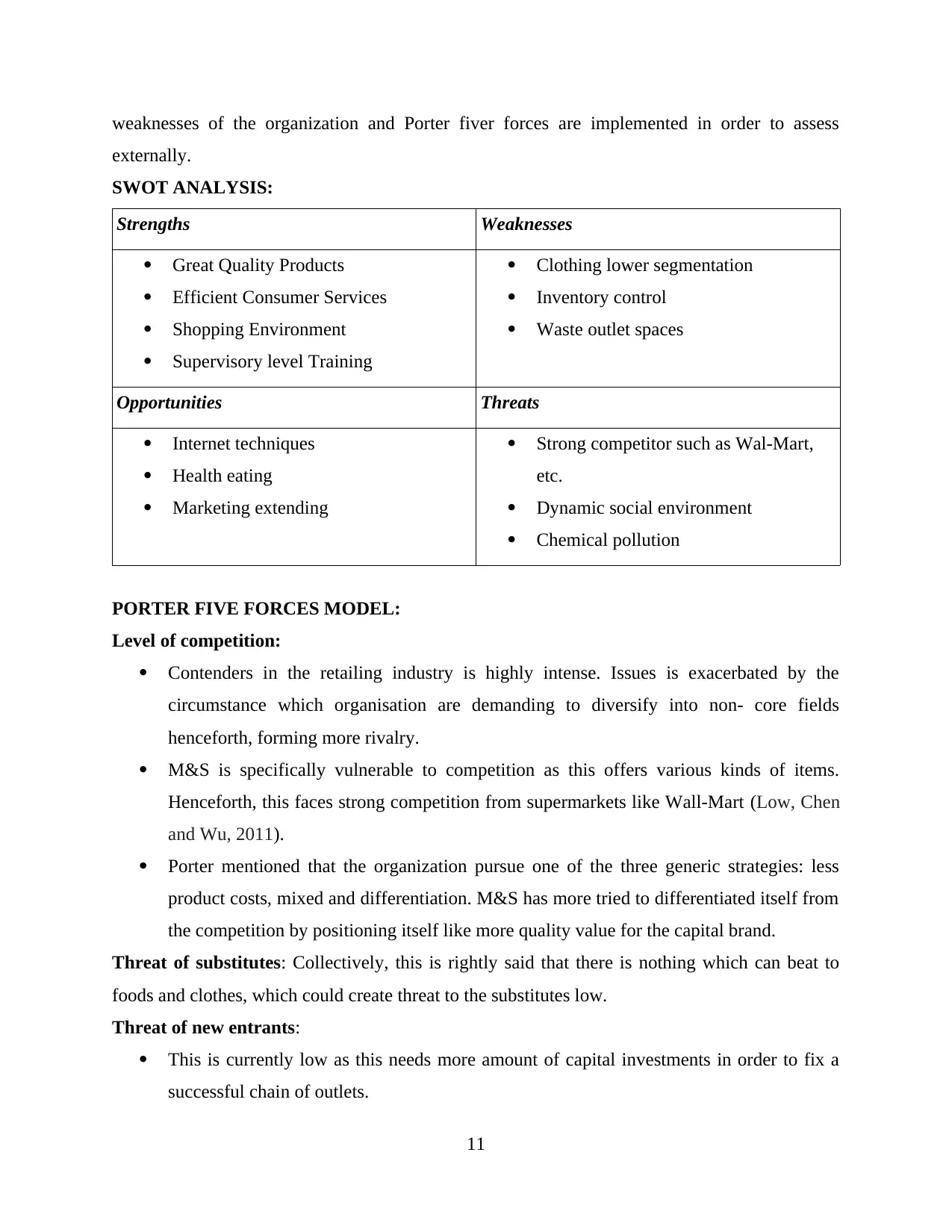
weaknesses of the organization and Porter fiver forces are implemented in order to assess
externally.
SWOT ANALYSIS:
Strengths Weaknesses
Great Quality Products
Efficient Consumer Services
Shopping Environment
Supervisory level Training
Clothing lower segmentation
Inventory control
Waste outlet spaces
Opportunities Threats
Internet techniques
Health eating
Marketing extending
Strong competitor such as Wal-Mart,
etc.
Dynamic social environment
Chemical pollution
PORTER FIVE FORCES MODEL:
Level of competition:
Contenders in the retailing industry is highly intense. Issues is exacerbated by the
circumstance which organisation are demanding to diversify into non- core fields
henceforth, forming more rivalry.
M&S is specifically vulnerable to competition as this offers various kinds of items.
Henceforth, this faces strong competition from supermarkets like Wall-Mart (Low, Chen
and Wu, 2011).
Porter mentioned that the organization pursue one of the three generic strategies: less
product costs, mixed and differentiation. M&S has more tried to differentiated itself from
the competition by positioning itself like more quality value for the capital brand.
Threat of substitutes: Collectively, this is rightly said that there is nothing which can beat to
foods and clothes, which could create threat to the substitutes low.
Threat of new entrants:
This is currently low as this needs more amount of capital investments in order to fix a
successful chain of outlets.
11
externally.
SWOT ANALYSIS:
Strengths Weaknesses
Great Quality Products
Efficient Consumer Services
Shopping Environment
Supervisory level Training
Clothing lower segmentation
Inventory control
Waste outlet spaces
Opportunities Threats
Internet techniques
Health eating
Marketing extending
Strong competitor such as Wal-Mart,
etc.
Dynamic social environment
Chemical pollution
PORTER FIVE FORCES MODEL:
Level of competition:
Contenders in the retailing industry is highly intense. Issues is exacerbated by the
circumstance which organisation are demanding to diversify into non- core fields
henceforth, forming more rivalry.
M&S is specifically vulnerable to competition as this offers various kinds of items.
Henceforth, this faces strong competition from supermarkets like Wall-Mart (Low, Chen
and Wu, 2011).
Porter mentioned that the organization pursue one of the three generic strategies: less
product costs, mixed and differentiation. M&S has more tried to differentiated itself from
the competition by positioning itself like more quality value for the capital brand.
Threat of substitutes: Collectively, this is rightly said that there is nothing which can beat to
foods and clothes, which could create threat to the substitutes low.
Threat of new entrants:
This is currently low as this needs more amount of capital investments in order to fix a
successful chain of outlets.
11
Paraphrase This Document
Need a fresh take? Get an instant paraphrase of this document with our AI Paraphraser
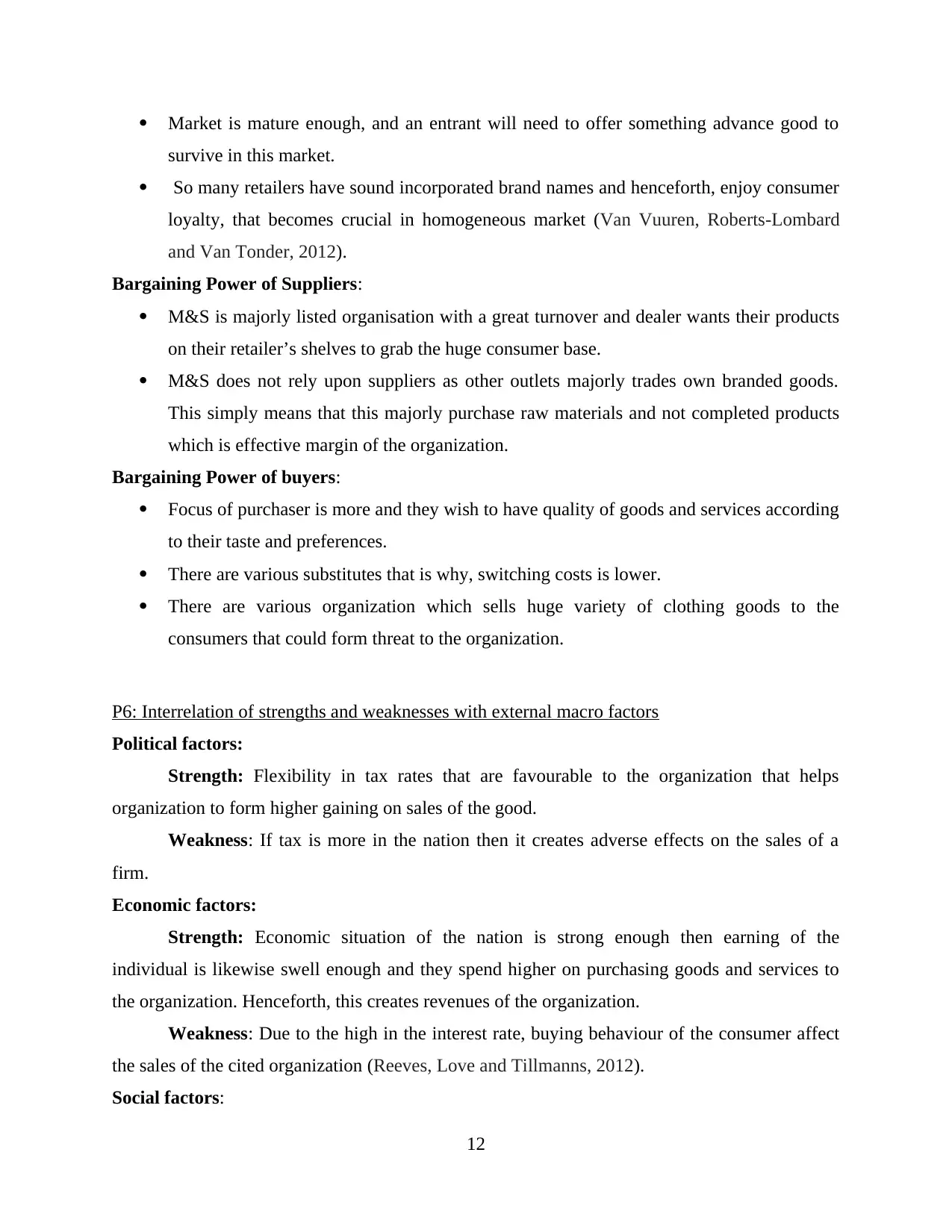
Market is mature enough, and an entrant will need to offer something advance good to
survive in this market.
So many retailers have sound incorporated brand names and henceforth, enjoy consumer
loyalty, that becomes crucial in homogeneous market (Van Vuuren, Roberts-Lombard
and Van Tonder, 2012).
Bargaining Power of Suppliers:
M&S is majorly listed organisation with a great turnover and dealer wants their products
on their retailer’s shelves to grab the huge consumer base.
M&S does not rely upon suppliers as other outlets majorly trades own branded goods.
This simply means that this majorly purchase raw materials and not completed products
which is effective margin of the organization.
Bargaining Power of buyers:
Focus of purchaser is more and they wish to have quality of goods and services according
to their taste and preferences.
There are various substitutes that is why, switching costs is lower.
There are various organization which sells huge variety of clothing goods to the
consumers that could form threat to the organization.
P6: Interrelation of strengths and weaknesses with external macro factors
Political factors:
Strength: Flexibility in tax rates that are favourable to the organization that helps
organization to form higher gaining on sales of the good.
Weakness: If tax is more in the nation then it creates adverse effects on the sales of a
firm.
Economic factors:
Strength: Economic situation of the nation is strong enough then earning of the
individual is likewise swell enough and they spend higher on purchasing goods and services to
the organization. Henceforth, this creates revenues of the organization.
Weakness: Due to the high in the interest rate, buying behaviour of the consumer affect
the sales of the cited organization (Reeves, Love and Tillmanns, 2012).
Social factors:
12
survive in this market.
So many retailers have sound incorporated brand names and henceforth, enjoy consumer
loyalty, that becomes crucial in homogeneous market (Van Vuuren, Roberts-Lombard
and Van Tonder, 2012).
Bargaining Power of Suppliers:
M&S is majorly listed organisation with a great turnover and dealer wants their products
on their retailer’s shelves to grab the huge consumer base.
M&S does not rely upon suppliers as other outlets majorly trades own branded goods.
This simply means that this majorly purchase raw materials and not completed products
which is effective margin of the organization.
Bargaining Power of buyers:
Focus of purchaser is more and they wish to have quality of goods and services according
to their taste and preferences.
There are various substitutes that is why, switching costs is lower.
There are various organization which sells huge variety of clothing goods to the
consumers that could form threat to the organization.
P6: Interrelation of strengths and weaknesses with external macro factors
Political factors:
Strength: Flexibility in tax rates that are favourable to the organization that helps
organization to form higher gaining on sales of the good.
Weakness: If tax is more in the nation then it creates adverse effects on the sales of a
firm.
Economic factors:
Strength: Economic situation of the nation is strong enough then earning of the
individual is likewise swell enough and they spend higher on purchasing goods and services to
the organization. Henceforth, this creates revenues of the organization.
Weakness: Due to the high in the interest rate, buying behaviour of the consumer affect
the sales of the cited organization (Reeves, Love and Tillmanns, 2012).
Social factors:
12
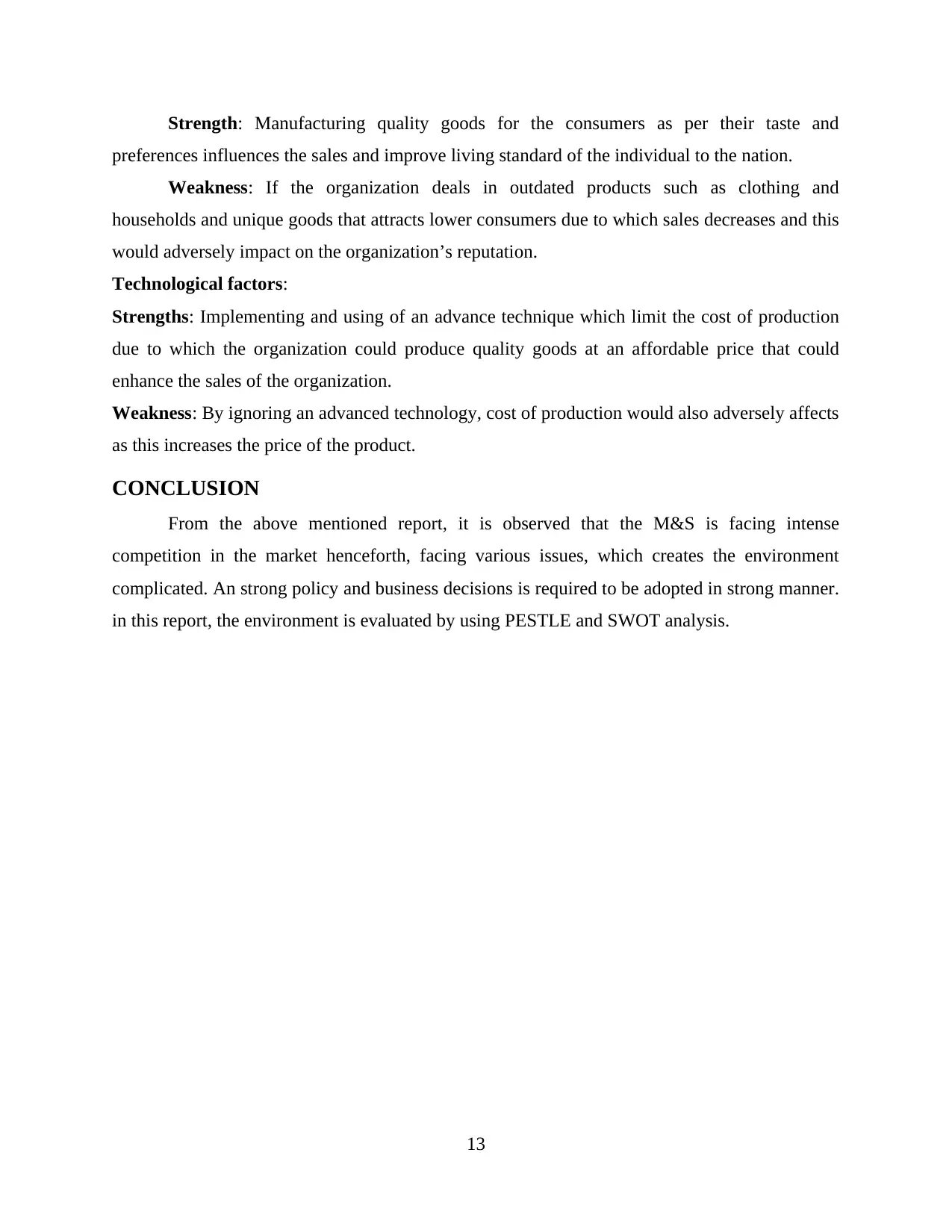
Strength: Manufacturing quality goods for the consumers as per their taste and
preferences influences the sales and improve living standard of the individual to the nation.
Weakness: If the organization deals in outdated products such as clothing and
households and unique goods that attracts lower consumers due to which sales decreases and this
would adversely impact on the organization’s reputation.
Technological factors:
Strengths: Implementing and using of an advance technique which limit the cost of production
due to which the organization could produce quality goods at an affordable price that could
enhance the sales of the organization.
Weakness: By ignoring an advanced technology, cost of production would also adversely affects
as this increases the price of the product.
CONCLUSION
From the above mentioned report, it is observed that the M&S is facing intense
competition in the market henceforth, facing various issues, which creates the environment
complicated. An strong policy and business decisions is required to be adopted in strong manner.
in this report, the environment is evaluated by using PESTLE and SWOT analysis.
13
preferences influences the sales and improve living standard of the individual to the nation.
Weakness: If the organization deals in outdated products such as clothing and
households and unique goods that attracts lower consumers due to which sales decreases and this
would adversely impact on the organization’s reputation.
Technological factors:
Strengths: Implementing and using of an advance technique which limit the cost of production
due to which the organization could produce quality goods at an affordable price that could
enhance the sales of the organization.
Weakness: By ignoring an advanced technology, cost of production would also adversely affects
as this increases the price of the product.
CONCLUSION
From the above mentioned report, it is observed that the M&S is facing intense
competition in the market henceforth, facing various issues, which creates the environment
complicated. An strong policy and business decisions is required to be adopted in strong manner.
in this report, the environment is evaluated by using PESTLE and SWOT analysis.
13
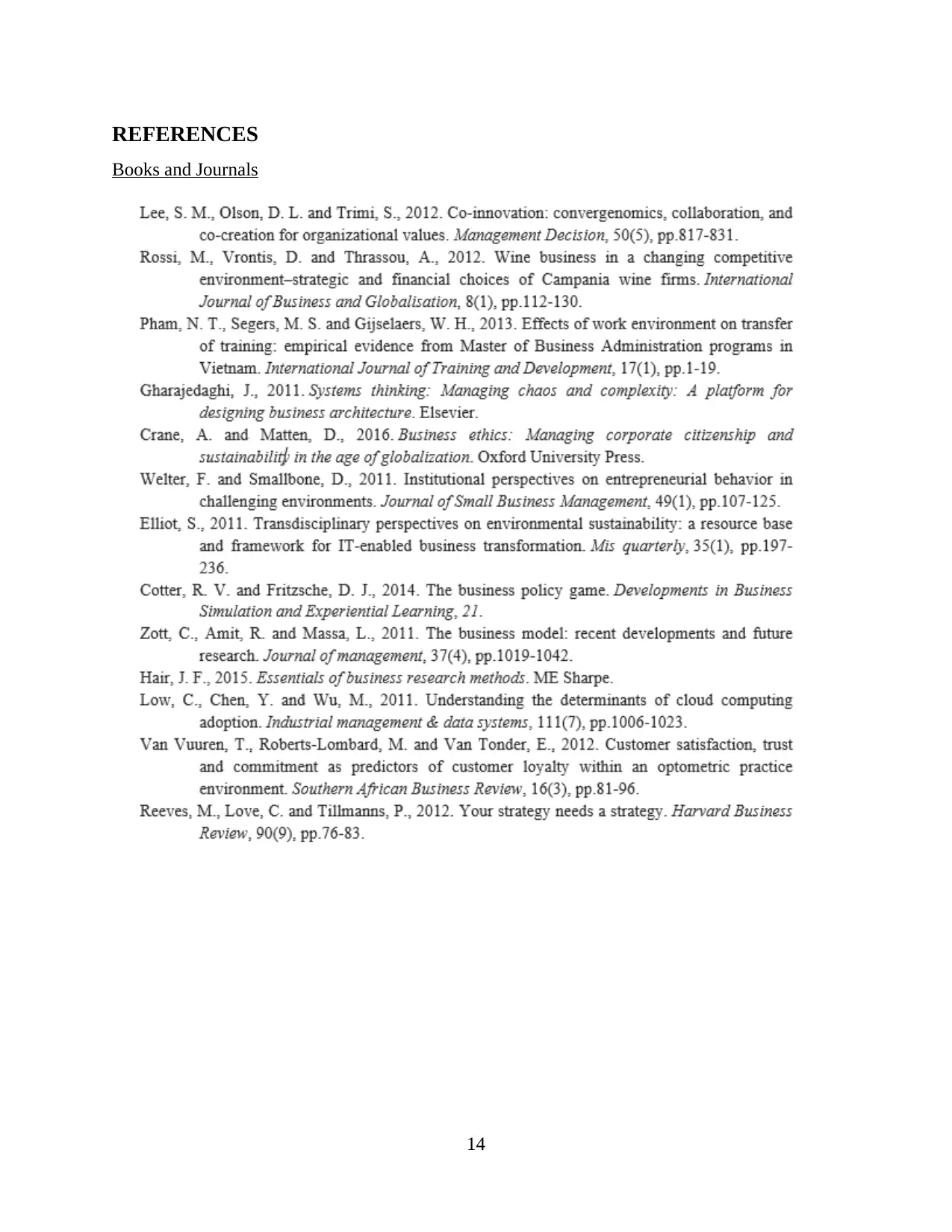
REFERENCES
Books and Journals
14
Books and Journals
14
1 out of 16
Related Documents
Your All-in-One AI-Powered Toolkit for Academic Success.
+13062052269
info@desklib.com
Available 24*7 on WhatsApp / Email
![[object Object]](/_next/static/media/star-bottom.7253800d.svg)
Unlock your academic potential
© 2024 | Zucol Services PVT LTD | All rights reserved.





